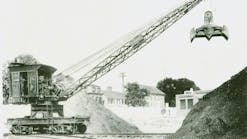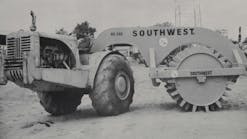On December 9, 2013, it was announced that Terex Corp. had sold its truck lines to Volvo Construction Equipment. Some observers noted that the sale took the story of Euclid trucks full circle. Not exactly, but the sale is the latest chapter in a lengthy and complicated story.
The company that became Euclid was founded in 1907 in Wickliffe, Ohio, by George A. Armington as Armington Electric Hoist. It was renamed Euclid Crane & Hoist when the plant was relocated to Euclid, Ohio. Euclid built experimental tractors, one crawler and several wheeled, in the 1920s, and entered the construction equipment industry when it introduced the Automatic Rotary Scraper in 1924. Acceptance of the scrapers led to the creation of the Road Machinery Division in 1926, and the Division was incorporated as Euclid Road Machinery, a subsidiary of the Euclid Armington Corp., on July 11, 1931. Euclid Road Machinery became independent of Euclid Armington on January 1, 1933, and no record is known to exist of Euclid Crane & Hoist after this.
The Euclid Lineage
- Euclid rigid-frame trucks: Acquired by GM, US rights sold to White, then to Daimler-Benz, Clark, Volvo and Hitachi, absorbed into Hitachi; Scottish production and international sales retained by GM as genesis of the Terex truck line.
- Euclid articulated dumps: Added to the Euclid line by Daimler-Benz, discontinued soon afterward.
- KW Dart mining end dumps: Acquired by Unit Rig & Equipment; acquired by Northwest Engineering; assumed by Terex Corporation; sold to Bucyrus International; sold to Caterpillar.
- Payhauler all-wheel-drive end dumps: Developed by I-H in 1964, sold to Payhauler Corporation, sold to Terex, discontinued.
- Terex construction end dumps: Continued in Scotland from Euclid manufacture; new designs introduced in U. S. in 1972 and consolidated to Scotland; sold to Volvo in 2013.
- Terex mining end dumps: Developed by Terex; manufactured in London, Ontario; sold to Marathon LeTourneau.
- Terex articulated dumps: Developed by Terex in Scotland; sold to Volvo in 2013.
- Unit Rig mining end dumps: Acquired by Northwest Engineering; assumed by Terex Corporation; sold to Bucyrus International; sold to Caterpillar.
Euclid Road Machinery introduced a variety of allied equipment for crawler tractors, but its biggest breakthrough came with development of the first true off-highway end dump and bottom dump trucks in the mid 1930s. Euclid came to dominate the market for these vehicles to the point that “Euc” came to be used generically for them. After World War II, motor scrapers were added to the product line, using the tractors that pulled the bottom dump wagons, and Euclid began production of trucks and scrapers in Motherwell, Scotland, in 1951.
General Motors, which had been exploring entry into the heavy construction equipment market, acquired Euclid on September 30, 1953, and made it a division of GM on January 1, 1954. In the mid-1950s, GM built a new factory for Euclid at Hudson, Ohio; in 1954, the Euclid product line was expanded to include crawler tractors and, in 1959, wheel loaders.
On October 15, 1959, the U.S. Department of Justice filed an anti-trust action against General Motors, alleging that GM threatened to control the off-road hauler market. To settle, GM negotiated with White Motor Corp. during 1967 for the sale of certain parts of its Euclid Division, and on February 15, 1968, White purchased the American operations for the Division and the Euclid name. GM retained the former Euclid lines of crawler tractors, motor scrapers and wheel loaders, which it marketed under the Earthmoving Equipment Division name. It also retained the right to build and market haulers from Canadian plants and the former Euclid factory in Scotland, but it was barred from re-entering the U.S. hauler market until July 1, 1972.
White operated Euclid as a subsidiary under the name of Euclid, Inc., then sold it to Daimler-Benz AG as a subsidiary in August, 1977. Daimler-Benz sold Euclid to the Clark Michigan Company, the construction machinery subsidiary of Clark Equipment, in January, 1984.
Responding to poor economic conditions, Clark formed a 50/50 joint venture company with Volvo AB in 1985. The new firm was called VME, an acronym for Volvo Michigan Euclid, and operated in separate units, Volvo BM in Europe and VME Americas in North America. The European unit became simply VME in 1989. In 1991, VME Americas was divided into VME Industries North America to handle Euclid products and VME Sales North America for Volvo’s wheel loaders and articulated trucks.
VME Industries North America formed a joint venture with Hitachi Construction Machinery Company Ltd. of Japan in December, 1993. Hitachi acquired a 19.5-percent share of the Euclid U.S. operations, and the venture was called Euclid-Hitachi Heavy Equipment Ltd. The VME name was eliminated in May, 1995, when Volvo’s parent company purchased Clark’s share of the VME venture, and the former VME was renamed Volvo Construction Equipment. By 1996, Hitachi had increased its share of Euclid to 40 percent. On January 1, 2004, Hitachi renamed its Euclid-Hitachi Heavy Equipment Ltd. business unit to Hitachi Construction Truck Manufacturing Ltd., abolishing the Euclid name.
While all this was going on, GM adopted Terex as the brand name for the Earthmoving Equipment Division in October, 1968. The British operation retained the Euclid (Great Britain), Ltd. name until December, 1968, when it was renamed General Motors Scotland, Ltd. The Earthmoving Equipment Division was officially renamed the Terex Division on July 1, 1970. The antitrust case did not affect either the Motherwell plant or truck sales outside the U.S., and GM continued producing end dumps similar to the Euclid designs at Motherwell. When the antitrust restrictions expired in 1972, GM re-entered the American market with its 33 series end dumps and 34 series coal hauler.
GM sold the Terex Division to IBH Holding AG on January 1, 1981, as part of IBH’s aggressive campaign of acquiring struggling equipment manufacturers. The Terex Division became Terex Corp., a subsidiary of IBH, with GM retaining a stake in IBH and remaining the freeholder of the Motherwell plant. IBH purchased the Scottish operations in a later, separate transaction. IBH continued the Terex name, incorporating Hanomag and Zettelmeyer Baumaschinen GmbH products into its product line and applying the Terex name and paint scheme to everything because of Terex’s brand recognition in the United States.
(Concurrently, Terex also produced a line of diesel-electric mine trucks at the Diesel Division, General Motors of Canada Ltd. locomotive plant in London, Ontario. This line was not included in the sale to IBH; the Diesel Division continued to manufacture them under Titan trade name, and the line was sold to Marathon LeTourneau in February, 1985.)
In 1983, Terex developed a line of articulated dump trucks for manufacture at the Motherwell plant, and these went on to become one of Terex’s most successful products. Euclid also marketed an articulated dump starting in 1983 with far less success; the Euclid truck was developed by Haulmasters, and was added to the Euclid line when Daimler-Benz, Euclid’s parent at the time, acquired Haulmasters.
IBH failed in November, 1983, and Terex Corp. filed for Chapter 11 bankruptcy protection against possible German creditor actions on November 8th. After German courts ordered the liquidation of IBH on December 14, 1983, GM repurchased Terex Ltd.’s UK operations on February 19, 1984, and reformed them as Terex Equipment Ltd., a subsidiary of GM. Terex Corp.’s U.S. operations continued independent of GM under bankruptcy laws, and it emerged from bankruptcy proceedings in August, 1986.
Excavator and crane manufacturer Northwest Engineering purchased Terex Corp. on December 31, 1986, with an option to purchase Terex Equipment Ltd. at a later date. The Hudson plant was not included in the Terex deal, although production continued there for a time under a lease with GM. The option on Terex Equipment Ltd. was exercised on June 30, 1987.
Northwest had been acquired by Randolph W. Lenz in 1983; in 1985, Lenz began his campaign of purchasing other firms by acquiring the remaining Bucyrus-Erie construction products lines in 1985. Bucyrus-Erie had acquired The Hy-Dynamic Company, producers of hydraulic cranes and Dynahoe loader/backhoes, in 1971. Former Bucyrus-Erie employees acquired the Hy-Dynamic lines and founded Bucyrus Construction Products (BCP) in Erie, Pennsylvania, in 1986 to manufacture them. BCP was acquired by Terex Corp., and was eventually spun off.
In May, 1988, after purchasing Unit Rig & Equipment, manufacturer of the Lectra Haul mine truck line (and which itself had purchased fellow hauler manufacturer KW Dart in 1984), Northwest assumed the Terex Corp. name, designating the U.S. operations the Terex Division and retaining the Terex Equipment Ltd. name for the Scottish operations. Northwest became a division of Terex, the company it had acquired. The Hudson plant was closed in September, 1988, and operations were moved to Motherwell; part of the Hudson plant is now used by Jo-Ann Fabric and Craft Stores.
Terex went public in 1988, and in the late 1980s it embarked on a years-long campaign of aggressive expansion by purchasing numerous other manufacturers of a wide range of products. By 1997, Terex Corp. had established two business divisions, Terex Trucks and Terex Cranes. Terex Trucks included all earthmoving, construction and mining equipment companies, including Terex Equipment, Ltd. and Unit Rig.
Yet another truck line was added in 1998, when Terex acquired the Payhauler line of four-wheel-drive off-highway end dump trucks first developed by International Harvester in 1964. The line had been spun off to former I-H employees who launched Payhauler in 1982 to continue it. In the early 2000s, the original line of Terex haulers produced in Motherwell was part of the Terex Construction Division under the Terex Equipment Ltd. Scotland name, and the former Unit Rig and Payhauler lines were in the Terex Mining Division.
Terex began spinning off various lines in the early 2000s, and in February 2010, Bucyrus International, which was descended from Bucyrus-Erie, acquired the mining equipment lines of Terex Corp., including Unit Rig & Equipment. (Recall that Terex had acquired the former Bucyrus-Erie Dynahoe line.) The lines were re-branded as Bucyrus. Bucyrus, in turn, was acquired by Caterpillar, Inc. in July 2011, and soon all former Bucyrus products and operations were rebranded for Caterpillar. The Payhauler line was discontinued in the early 2000s.
And so, with the sale of the remaining truck lines to Volvo, the lineage of the end dump hauler lines affiliated with Terex plays out this way:
- Euclid rigid-frame trucks: Acquired by GM, US rights sold to White, then to Daimler-Benz, Clark, Volvo and Hitachi, absorbed into Hitachi; Scottish production and international sales retained by GM as genesis of the Terex truck line.
- Euclid articulated dumps: Added to the Euclid line by Daimler-Benz, discontinued soon afterward.
- KW Dart mining end dumps: Acquired by Unit Rig & Equipment; acquired by Northwest Engineering; assumed by Terex Corporation; sold to Bucyrus International; sold to Caterpillar.
- Payhauler all-wheel-drive end dumps: Developed by I-H in 1964, sold to Payhauler Corporation, sold to Terex, discontinued.
- Terex construction end dumps: Continued in Scotland from Euclid manufacture; new designs introduced in U. S. in 1972 and consolidated to Scotland; sold to Volvo in 2013.
- Terex mining end dumps: Developed by Terex; manufactured in London, Ontario; sold to Marathon LeTourneau.
- Terex articulated dumps: Developed by Terex in Scotland; sold to Volvo in 2013.
- Unit Rig mining end dumps: Acquired by Northwest Engineering; assumed by Terex Corporation; sold to Bucyrus International; sold to Caterpillar.
The Historical Construction Equipment Association (HCEA) is a 501(c)3 nonprofit organization dedicated to preserving the history of the construction, dredging and surface mining equipment industries. With more than 4,000 members in 25 countries, activities include operation of National Construction Equipment Museum and archives in Bowling Green, Ohio; publication of a quarterly magazine, Equipment Echoes, from which this text is adapted, and hosting an annual working exhibition of restored construction equipment. Individual memberships are $32 within the U.S. and Canada, and $40 elsewhere. Information is available at www.hcea.net, 419.352.5616, or [email protected].





